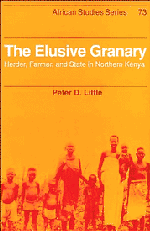Book contents
- Frontmatter
- Contents
- List of illustrations
- List of tables
- Preface
- 1 Introduction: the study of agrarian change among African herders
- 2 Society, ecology, and history
- 3 Markets and the state
- 4 Labor and agropastoral production
- 5 Income, wages, and investment
- 6 Expenditures, consumption, and the food crisis
- 7 Land conflicts and sustainability
- 8 In pursuit of the granary: development responses of community, donor, and state
- Notes
- References
- Index
- AFRICAN STUDIES SERIES
3 - Markets and the state
Published online by Cambridge University Press: 04 August 2010
- Frontmatter
- Contents
- List of illustrations
- List of tables
- Preface
- 1 Introduction: the study of agrarian change among African herders
- 2 Society, ecology, and history
- 3 Markets and the state
- 4 Labor and agropastoral production
- 5 Income, wages, and investment
- 6 Expenditures, consumption, and the food crisis
- 7 Land conflicts and sustainability
- 8 In pursuit of the granary: development responses of community, donor, and state
- Notes
- References
- Index
- AFRICAN STUDIES SERIES
Summary
Marketing patterns in Baringo evolved in response to a particular set of historical and ecological conditions. As in other parts of East Africa, the range of agroecosystems permitted a system of exchange to develop in the precolonial period, whereby herders of the semiarid zone traded livestock and its products to the agriculture sector in exchange for grain (see Hjort 1981b). Neither vertical marketing systems nor marketplaces existed at the time, but there was horizontal barter exchange between the settlements and herders who used the area: the Maasai from the south and the Pokot and Samburu from the north. It was these exchange relations that helped to define the role of the II Chamus in larger regional systems of northern Kenya. As noted in the previous chapter, the II Chamus settlements also exchanged grain with trade caravans en route to the African interior.
This chapter focuses on marketing in the colonial and independence eras, with particular attention to the role of the state in controlling marketplaces and distribution systems. I suggest that market centers in Baringo grew in response to the demands of the colonial state, rather than as a result of increased commercial activity. When a government post was established, the administration also encouraged the establishment of one or more retail stores for providing supplies for government employees, fostering a sense of permanency, and competing with itinerant traders, who were the bane of the state because it could not control them. This policy of encouraging market settlements around administrative posts – while discouraging mobile traders – was pursued in many parts of northern Kenya (Dalleo 1975: 145; Sobania 1988: 233).
- Type
- Chapter
- Information
- The Elusive GranaryHerder, Farmer, and State in Northern Kenya, pp. 40 - 62Publisher: Cambridge University PressPrint publication year: 1992



